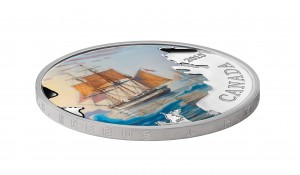On today’s date in 2014, Parks Canada announced the wreckage of one of Sir John Franklin’s ships was found the previous day using a recently acquired remotely operated underwater vehicle.
The September 2014 expedition discovered the wreck of HMS Erebus in an area identified by Inuit while the wreck of HMS Terror was located two years later.
“Historical research, Inuit knowledge and the support of many partners made these discoveries possible,” according to an article published on the Parks Canada website.
“Now Inuit and Parks Canada are working together to jointly manage this fascinating National Historic Site.”
Public access to the wrecks is currently prohibited.
More recently, in August 2019, underwater archeologists spent a week exploring the wreck, which sits in “incredible” condition about 24 metres below the surface of Terror Bay near King William Island, Nunavut.
“Overall I think what surprised us most was just the incredible state of preservation,” project director Ryan Harris was quoted as saying by CBC News.
Conducting nearly 50 dives in one month, the team focused on structurally mapping the wreck in 3D.
“Really the highlight of that seven-day period of work on the Terror was a series of exploratory searches inside with our remotely operated vehicle,” Harris told CBC, adding there’s “real potential” to discover historic artifacts from the 19th-century wreck.
FRANKLIN EXPEDITIONS
In 1845, Franklin set sail from England with two ships – Erebus and Terror – in search of a Northwest Passage across what’s now Canada’s Arctic.
While Franklin’s ships and crew were last seen by Inuit on King William Island, they never returned to England and a massive search followed for nearly two centuries.
In 2015 – 170 years after Franklin and his crew set sail on a journey from which they would never return – the Royal Canadian Mint issued a silver collector coin commemorating the unforgettable story of the famed Franklin Expedition, whose tragic loss of all men and their ships in Arctic waters have left an indelible mark on Canadian and maritime history.
“The Franklin Expedition is a very important event in Canadian history which laid the foundations of Canada’s Arctic sovereignty nearly two centuries ago,” said Peter MacKay, then-minister of justice and attorney general.
Designed by noted Canadian maritime artist John Horton, the second coin in the $20 Fine silver “Lost Ships in Canadian Waters” series depicts an illustration of both the Terror and Erebus navigating the icy waters of the Arctic Ocean.
The coloured coin shows the Erebus, whose 2014 discovery by Canada’s Victoria Strait Expedition is one of the century’s greatest achievements in maritime archeology, in the foreground, and the Terror appears to starboard. The words “H.M.S. Erebus” and “H.M.S. Terror” are also engraved along the coin’s edge.
The coin has a weight of 31.39 grams, a 38-millimetre diameter and a mintage of 7,000 pieces.


